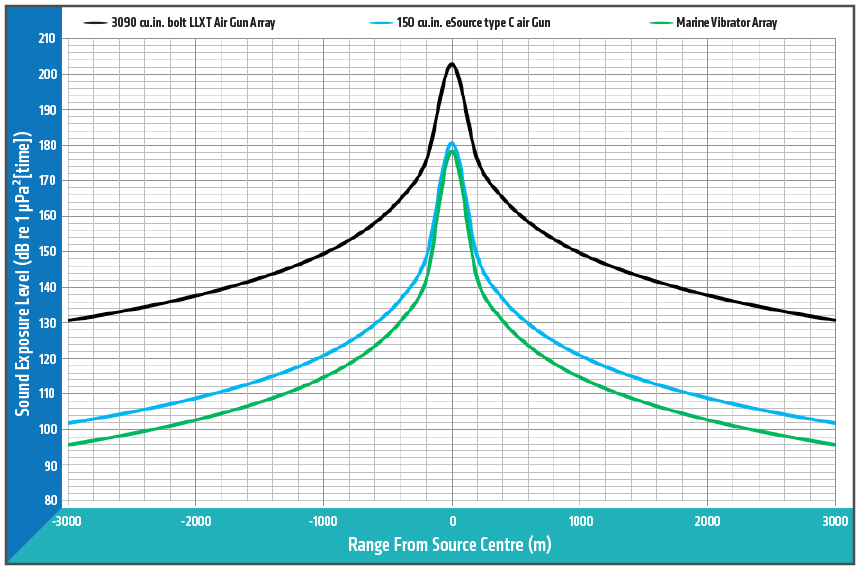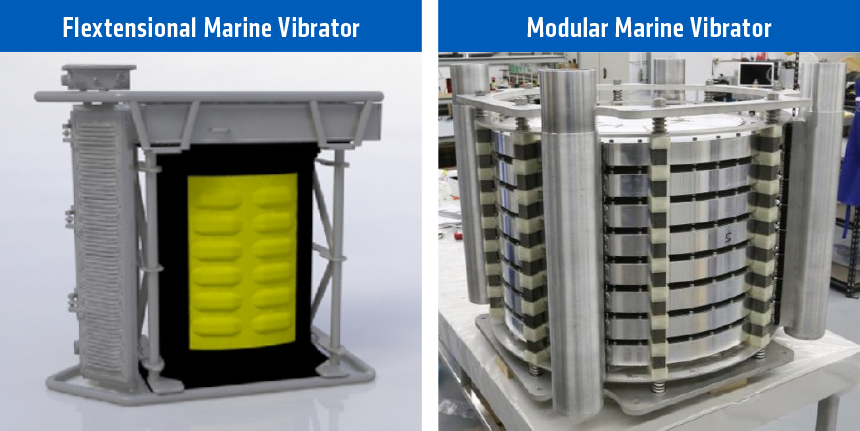- Lower sound pressure level (SPL) and sound exposure level (SEL) than any type of air guns, and potentially less environmental impact
- Creates opportunities for new and flexible source geometries, in the 5-100 Hz frequency range, as no air compressors are required
- Ultra-low frequency potential in the 2-6 Hz frequency range: Beneficial for FWI, elastic impedance inversion, and deep signal penetration.
There is a wealth of knowledge available on the physics of underwater acoustic noise, but sensational claims are often made about the potential physiological and behavioral effects of acoustic noise on marine animals at various ranges, magnitudes and duration. In reality, there has been no documented scientific evidence of noise from air guns used in geological and geophysical (G&G) seismic activities adversely affecting marine animal populations or coastal communities, and the only publications that describe physiological damage involved the deliberate firing of air guns in the immediate proximity of marine animals for sustained periods.
Air Guns Versus Marine Vibrators
At the heart of all claimed impacts of traditional marine sources is the fact that air guns have an impulsive acoustic signature. The rise time between the ambient background noise level and the maximum acoustic amplitude is only a few milliseconds, 99% of the energy is typically released into the water in only about 30 milliseconds (0.03 seconds), and the maximum amplitude is comparable to or louder than the calls of large whales.
By comparison, the acoustic signature of marine vibrators has a continuous (or transient) nature: The rise time between the ambient background noise level and the maximum acoustic amplitude may be several seconds, the energy is emitted in a reasonably uniform manner over 5 to 30 seconds (or more), and the maximum amplitude may be significantly less than impulsive acoustic seismic sources. Furthermore, the acoustic amplitude emitted at frequencies above about 100 Hz will be substantially weaker by comparison to impulsive acoustic seismic sources.
Environmental Impact
The activity of seismic surveys in areas designated as environmentally sensitive is regulated by a series of established received sound metrics which include sound pressure level (SPL) and sound exposure level (SEL); together applicable to both impulsive (air gun) and transient (marine vibrator) acoustic noise types. Specific SPL and SEL thresholds are used to dictate how surveys may operate at various distances from either observed marine mammals, marine parks, commercial fisheries, and so on.
A comparison of SEL versus range is made in the figure below for a 3090 cubic inch array of Bolt LLXT air guns, a single 150 cubic inch eSource air gun (Type C setting), and a compact marine vibrator array. The SEL is computed by integrating the emitted energy over the entire duration of the modeled source signatures: 2 seconds for the air gun array and the eSource air gun, and 10 seconds for the marine vibrator array, and all plotted at a common depth of 30 meters below sea level. At 1000 m range the marine vibrator array SEL of 115 dB is 34 dB (98%) less than the air gun array SEL of 149 dB, and 6 dB (50%) less than the single eSource air gun SEL of 121 dB. At 3000 m range the marine vibrator array SEL of 96 dB is 35 dB (98.2%) less than the air gun array SEL of 131 dB, and 6 dB (50%) less than the single eSource air gun SEL of 102 dB (both acoustic wavefields decay equally with increasing range).
On face value, these are compelling numbers, but again it is noted that the air gun array has a short impulsive signal with negligible masking effects, and the marine vibrator array has a continuous signal with potential (albeit unproven) masking effects. Note that no auditory threshold filters for specific marine species have been applied to the modeled SEL values.
 Modeled SEL at 30 m depth for -3000 to +3000 m range in the cross-line direction for a 3090 cubic inch array of Bolt LLXT air guns, a single 150 cubic inch eSource (Type C) air gun, and a compact array of marine vibrators.
Modeled SEL at 30 m depth for -3000 to +3000 m range in the cross-line direction for a 3090 cubic inch array of Bolt LLXT air guns, a single 150 cubic inch eSource (Type C) air gun, and a compact array of marine vibrators.
Marine vibrator concepts have been around for several decades but never found commercial application. Originally, people tried to adapt land seismic vibroseis apparatus with heavy base plates coupled to hydraulic machinery for vessel operations but they literally shook the vessels apart. Later marine vibrator concepts have used some kind of hollow body with an internal drive mechanism that dynamically changes the volume of the vibrator body in response to a sweep signal. That driver may be a hydraulic piston, a linear motor that changes the air pressure within the vibrator (again a type of piston), or some kind of electric system using magnets that is analogous to the coil within acoustic loudspeakers. Changes in the volume of the vibrator body displace the water around the body, and that process emits acoustic wavefields through the water that are an alternative to the acoustic wavefields emitted by air ‘guns’ (actually hollow chambers that periodically release compressed air at 2000 psi).
Physics Fundamentals
Simple physics allow the action of a marine vibrator to be described in terms of a pulsating sphere: A marine vibrator unit can be viewed as a ‘point source’ as its dimensions are much smaller than the seismic wavelengths of interest. The harmonically changing volume displaces the surrounding water, thereby emitting an acoustic pressure wavefield, and the volume of water that must be displaced per frequency cycle to emit a specific sound pressure level can be described mathematically, increasing exponentially towards the lowest frequencies of interest. Correspondingly, the design of marine vibrators has faced two main challenges: 1. How can a broadband signal spectrum that spans the main frequencies of seismic interest emitted by air guns (5-100 Hz) be efficiently produced, particularly at lower frequencies, and 2. How can ‘large’ sound pressure level amplitudes comparable to modern air gun arrays be efficiently produced for all such frequencies? Aside from very shallow water operations (less than 10 m depth) where it may be more practical to lay the marine vibrator units on the seafloor during each sweep, marine vibrator development has always had the goal of survey efficiency equal to, or greater than, towed streamer 3D operations, i.e. the vibrator units are towed behind the streamer vessel in the manner of air gun arrays. PGS has been trying to address these challenges for many years, and some insights are briefly shared below.
Working Hard or Sharing the Work
The photos below show the two marine vibrator concepts that PGS has been pursuing for many years in R&D. The flextensional concept on the left uses an electric driver and powerful magnets to bend spring elements within a fiberglass shell. By intelligent design, the resonance frequencies for both the driver mechanism and the spring elements occur within the seismic frequency band of interest for two different unit sizes. As a consequence, only two vibrator units are required to emit relatively uniform amplitudes over the frequency range of 5-100 Hz. The units are designed to be towed at depths between 8 and 30 m. They require no internal pressure compensation or onboard air compressors. The large surface area of each unit moves with a large displacement during each frequency cycle. Alternatively, the concept on the right of the figure below uses the small displacement of many small surfaces to achieve a comparable net displacement of water per frequency cycle, also using an electric driver mechanism. Again, the traditional seismic frequency band of interest can be emitted using different unit sizes working in combination.
 Flextensional marine vibrator concept that displaces a large volume of water per unit and the modular marine vibrator concept that displaces a small volume of water per surface but uses many surfaces.
Flextensional marine vibrator concept that displaces a large volume of water per unit and the modular marine vibrator concept that displaces a small volume of water per surface but uses many surfaces.
Ultra-Low Frequency Opportunities
If very large volumes of water can be displaced per frequency cycle at ultra-low frequencies (for example, 1.1 cubic meters per cycle at 2 Hz to emit a sound pressure level of 200 dB re 1 µPa at 1 m distance), marine vibrators could facilitate more robust Full Waveform Inversion (FWI) and elastic seismic inversion than is possible using air guns. Special marine vibrator designs are required to operate at large depths (60-120 m) necessary for the source ghost effect to be optimized for ultra-low frequency generation.
Overcoming the Dogma of Air Gun Array Design
Many air guns of differing volumes are traditionally required in an air gun array in order to yield a relatively smooth amplitude spectrum: The principle known as ‘array tuning’. As a consequence, the net sound pressure level (SPL) of air gun arrays is in the vicinity of 240-250 dB re 1 µPa at 1 m distance. Conversely, only a small number of marine vibrator units are required to yield a comparable relative amplitude spectrum, so the net SPL may be significantly lower by comparison. The industry dogma that very large source SPL is necessary to achieve acceptable seismic imaging of deep geological targets may be turned on its head if field trials of marine vibrators are successful.
If marine vibrator source arrays are not tethered to the streamer vessel by umbilical hoses to onboard air compressors it becomes possible to greatly increase the distance between the sources and the streamer vessel, it becomes far easier to deploy the source locations with large lateral separation, and ‘dispersed source array’ (DSA) survey designs become more tangible. Overall, major steps in 3D marine survey efficiency will be realized if towed marine vibrators can be commercialized.
Summary
Marine vibrators are not a new idea but the various designs, with a short-lived application over the past few decades, suffered from similar flaws: Operationally cumbersome, messy and inefficient hydraulic components, narrow frequency bandwidth, and so on. Whilst the PGS marine vibrator concepts elegantly use only electric driver mechanisms and emit relatively uniform amplitudes over the traditional 5-100 Hz frequency range, industry interest has not been historically motivated by the environmental and efficiency ambitions that have recently surged to prominence worldwide. Due to the growing opposition to air guns in many areas and extreme cost pressures in the global industry climate, it may now be time to enter a new era in marine seismic survey technology and allocate more E&P company funding to the commercialization of marine vibrator technology.
Contact a PGS expert
If you have a question related to our Marine Acquisition services or would like to request a quotation, please get in touch.